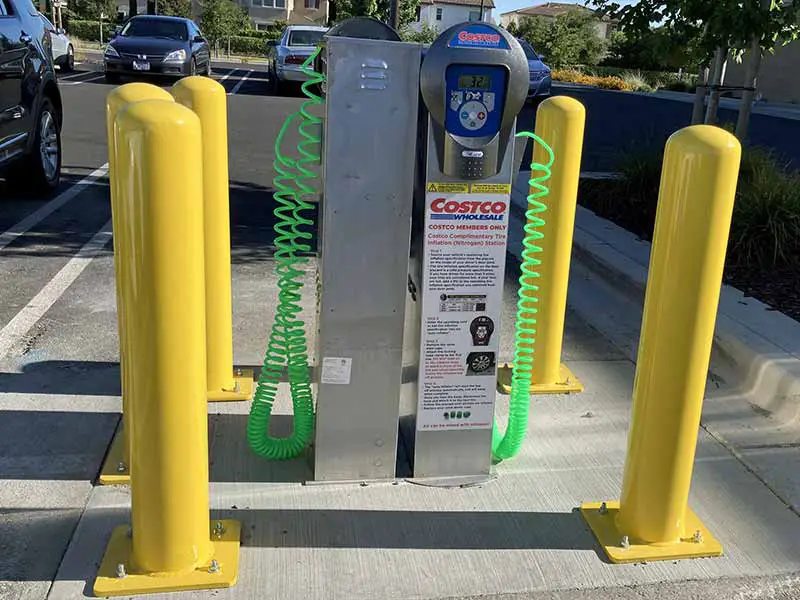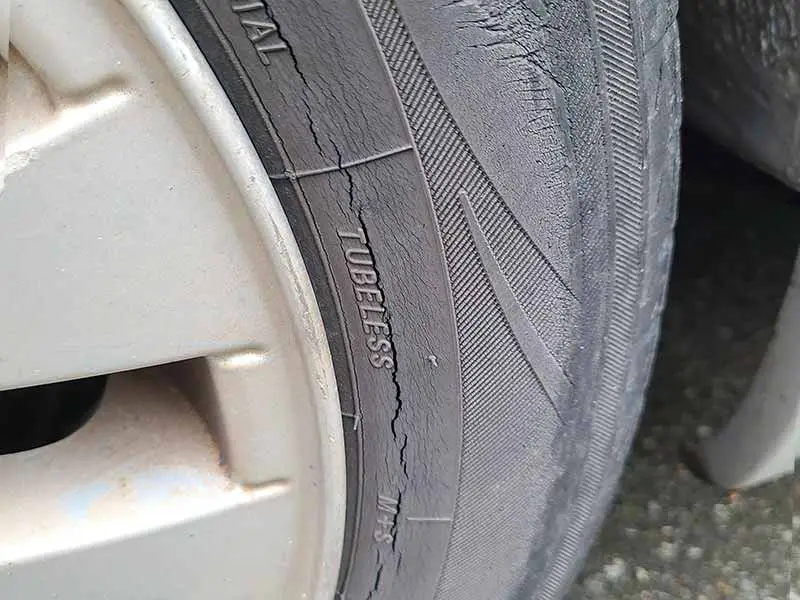Conventional tires last 50,000 to 60,000 miles typically, assuming there isn’t an issue with uneven wear or tire damage. The same is true for run flats. Run-flat tires wear the same as conventional tires and last just as long.
Run-flat tires usually come with a tire warranty that often includes a tire mileage guarantee. This guarantee will let you know how many miles you can expect to get out of your run-flat tires.
How Long Do Run-Flat Tires Last?
Run-flat tires last just as long as a standard tire under normal use, typically 50,000 to 60,000 miles. When punctured, they last 50 miles at a max speed of 50 mph.
Once punctured, a run-flat tire should be replaced with a brand new run-flat tire. They can not be patched like an ordinary tire.
A tire pressure monitoring system (TPMS) is required for the use of most run-flat tires since it may not be obvious that you have punctured a tire. All new vehicles these days come with TPMS, although some are better than others.
Let’s take a closer look.
Types Of Run Flat Tires
There are 3 main types of run-flat technology – self-supporting, self-sealing, and auxiliary-supported. Each of these types of run-flat tires will allow you to reach your destination after a minor puncture that would leave a car or truck with regular tires stranded or in need of installing a spare tire.
None are perfect, but they each have their pros and cons.
Self Supporting
Self-supporting run-flat tires are the most common type of run flat on the market and are found installed as OEM tires on many BMW, Mercedes Benz, Tesla, and other premium vehicles.
These tires work by increasing the structural integrity of the sidewall. The sidewall is designed to be capable of supporting the weight of your car or truck for a distance of 50 miles at a speed no greater than 50 miles per hour with zero air pressure.
This is meant to allow you to continue driving so you can reach a safe location to resolve the problem. You will need to rely on your TPMS system to alert you to the fact that you have lost tire pressure and reduce speed and be sure you can reach a safe destination.
The main complaint with self-supporting run-flat tires is the harsher ride quality due to the stiff sidewalls.
Self Sealing
Self-sealing tires are considered run flats, but that isn’t an entirely accurate name. A self-sealing tire will withstand a small puncture and seal the hole to prevent air loss. They can’t prevent all types of punctures and if the self-sealing feature fails to work and the tire loses air pressure, it won’t be able to be driven.
It is a run flat in the sense that if you’d been using standard tires you would have suffered a flat tire and would have needed to mount a spare tire, use an emergency tire inflation kit, or wait for a tow truck.
What’s important to note is that you won’t likely realize you’ve had a flat tire until after the fact. Not even your TPMS will alert since now tire pressure was lost. You don’t need to slow down or limit the distance you’re driving like with other run-flat tires.
Self-sealing tires have greater ride comfort than self-supporting tires, but they can’t resolve as wide of a range of punctures.
Auxiliary Supported
Auxiliary-supported run-flat tires are extremely rare these days. They were a run-flat tire technology that didn’t really catch on because they required a special wheel.
Auxiliary-supported run-flat tires rely on a support ring system that is mounted onto the wheel itself. Essentially, the tire is normal and operates just like any other tire, however, if you experience a flat tire, the support ring inside will support the vehicle’s weight and allow you to continue driving for 50 miles at 50 miles per hour.
This design is meant to fix the main downside of self-supporting run-flat tires, which is the harsher ride. Since the sidewalls of auxiliary supported tires could be designed in the same way as regular tires, there would be no negative effects on the ride’s smoothness.
How Long Do Run Flat Tires Last After A Puncture?
Most run-flat tires are designed to be used the same way a spare tire is used once they’ve been punctured:
- 50 MPH Maximum Speed
- 50 Miles Maximum Distance
You shouldn’t try to patch a run-flat tire and you will need to purchase new run-flat tires for any tires that have a puncture. This can be expensive for those that regularly drive in puncture-prone environments.
Self-sealing run-flat tires have no maximum speed or maximum distance limitations after they have been punctured as long as they are still able to hold the appropriate amount of inflation pressure.
The catch with self-sealing tires is that you’ll likely never know you had a puncture. But they will continue to be able to be used. If they ever do go flat, they too can not be repaired and you will need a new run-flat tire.
Do Run Flat Tires Need To Be Replaced After A Punctured Tire?
Run flat tires must be replaced once they have been punctured. They will have lost the necessary structural integrity to be safe for continued operation even if the puncture could be patched.
The exception to this is self-sealing run-flat tires. These tires will continue to work like conventional tires, although without losing pressure, and you will likely never realize it was punctured.
Can You Put Air In Run Flat Tires?
Run flat tires are supported with air pressure just like normal tires. The difference is that they have built-in countermeasures to handle a puncture.
Self-supporting and auxiliary supported run-flat tires can not be re-pressurized after a puncture and will need to be discarded and you will need to purchase a replacement tire.
Self-sealing run-flat tires can have air pressure added after a puncture, but if the tire isn’t able to properly seal and hold the required air pressure, they too will need to be discarded and replaced.
Nitrogen-Filled Run Flats
Tires are usually pressurized with compressed air but sometimes are filled with nitrogen. It’s generally recommended that if your tires are filled with nitrogen, you should top them up with nitrogen. Whether they are run-flat tires or not doesn’t matter.
You can usually tell if your tires have nitrogen instead of regular air in them by the use of green valve stem caps.

How Many Miles Do Run Flat Tires Last?
Conventional tires last 50,000 to 60,000 miles typically. Different types of tires last different amounts though.
For instance, sports car tires use a soft tread compound which shortens tire life. Most tires with this softer rubber formulation last much fewer miles. 30,000 to 35,000 miles is fairly common.
Run-flat tires will last just as long as conventional tires of a similar design. The fact that they are designed to run flat has no negative effects on how long run-flat tires last.
A run-flat tire will still have some downsides. Usually, run-flat tires are more expensive. Also, the self-supporting variety will have a rougher ride quality when compared to a conventional tire design.
How Many Years Do Run Flat Tires Last?
Run flat tires last the same amount of years as conventional tires last – six years.
Rubber compounds begin to degrade over time due to exposure to ozone in the atmosphere and ultraviolet rays from the sun. These environmental elements cause the rubber to begin to dry rot.
Once most tires that are regularly used reach the age of six years, dry rot will have advanced to a point that they become unsafe to use.
Most tires that are used regularly will run out of tread life before this happens so dry rot is not an issue for most car and truck owners.
It is possible for tires to last longer than six years if they are properly stored in a temperature-controlled environment, kept in air-tight bags, and away from direct sunlight.

Can You Replace Run Flat Tires With Regular Tires?
Many drivers decide to replace their run-flat tires with conventional tires when the tread wear of their OEM run flats has been used up.
There is no technical reason you can’t remove run-flat tires from your vehicle and replace them with conventional tires. There is nothing special about them beyond their ability to allow you to drive a short distance if you get a flat tire.
However, you should be prepared to deal with a flat if you do decide to replace your run flats with conventional tires.
Quality portable air pumps like the one above are much more accurate and reliable.
Tire Inflation Kit
I always recommend keeping a tire inflation kit in your car or truck. I personally recommend a quality inflator and a tire sealant like Fix-A-Flat or Tire Slime.
Spare Wheel
Many newer vehicles don’t come with spare tires these days. And many of these don’t even have room to store a spare wheel with a tire.
If you can find a spare tire that will fit your wheel bolt pattern and fit inside your vehicle, it’s a great way to ensure you won’t get stranded on the side of the road.
Roadside Assistance
If you don’t have an inflation kit or spare, you’ll need to rely on roadside assistance to either send out a tow truck or repair your tire by the side of the road where you’re stranded.
AAA is a good choice for many who prefer to go this route. Some car manufacturers provide roadside assistance for a period of time after the purchase of some new vehicles. If you’re unsure if you have coverage, check your owner’s manual.
Are Run Flat Tires Worth It?
Ultimately, it’s up to you to decide if run-flat tires are worth the trade-offs for you. Vehicle manufacturers benefit from removing spare tires from their new vehicles. It frees up storage space and many consumers like the sense of security a run-flat tire provides.
I personally don’t use them but I’m not necessarily opposed to them. I’ve never purchased a car or truck that had them installed and I’ve never decided to add them after the fact.
I’ve dealt with the inconvenience of waiting for a tow truck, mounting a spare tire, or using a tire sealant and portable tire inflator when I’ve been stranded with a flat tire.
If you can afford the increased cost and don’t mind the harsher ride of a tire with a reinforced sidewall and stiffer construction, it adds an extra layer of security that can be a real benefit.
Resources
Below are some links you may find helpful when learning about tires
Final Thoughts
Run-flat tires are a great alternative to spare tires for many. They allow you to get to a safe location and deal with the inconvenience of a flat tire on your own schedule.
They aren’t without their flaws, but for many, the pros outweigh the cons.
Good luck and happy motoring.





